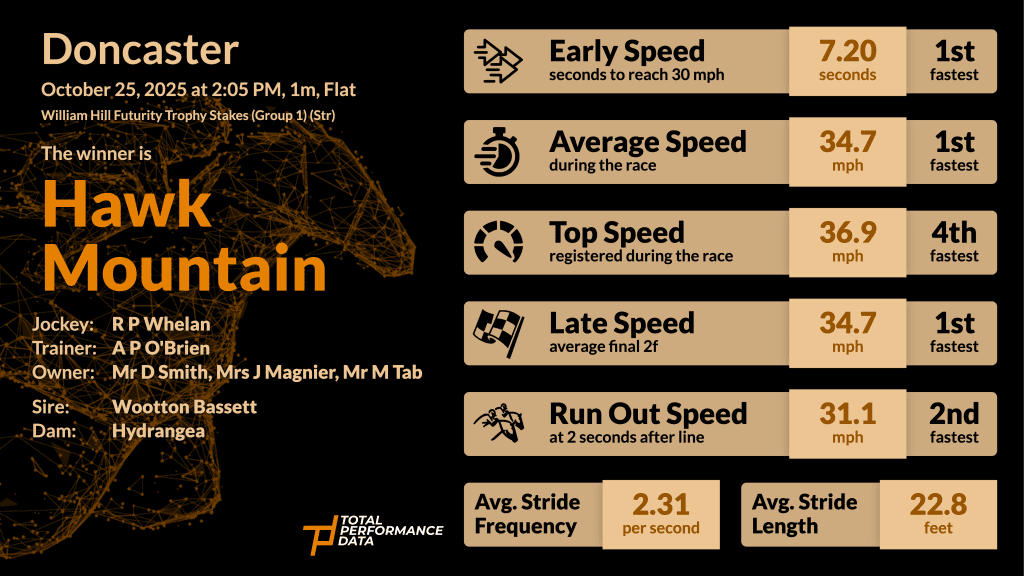William Hill Futurity Trophy Stakes (G1)
“Hawk Mountain”
In attritional conditions at Doncaster on Saturday, Aidan O’Brien landed his 12th Futurity Trophy. Given that he trained the first 3 in the betting and the only conceivable danger didn’t appear to handle the conditions at all, that is not an overly surprising result. Following this result, Hawk Mountain has been installed as the favourite for the Derby in 2026, but what can the data tell us about his chances and whether he is worthy of that position?


As can be seen from the graphic above, the first point to make is that he was the fastest horse in the field at the crucial stage of the race. A top speed of 36.9 mph may have ranked him 4th of 5, but in the latter stages, where he recorded the fastest final 2 furlong splits in 12.39 and 13.44s, he had the necessary late speed and perhaps more importantly stamina. To pay credit to the runner-up, we should point out that Action was just 0.08s slower than his stablemate over the final quarter of a mile, closing in 12.40 and 13.51s, but in the final furlong, when it mattered, Hawk Mountain put his head down and galloped through the line. A close examination of the TPD data would suggest that there is very little between the front 2, especially in these conditions. Hawk Mountain possessed a longer stride, recording a race average of 22.82 ft, compared to the 22.05 ft averaged by Action, but this result is not a simple case of the bigger horse grinding out a win in difficult conditions. To a large extent, the length of a horse’s stride is determined by their size and the ground on which they are running. However, the variance in that stride length can be a good pointer to their stamina and potential for improvement with both more time and more distance. If we take that approach to the data, then a case can be made that the runner-up is just as likely to improve when going beyond a mile in 2026 as Hawk Mountain will.
Hawk Mountain possessed the longer average stride, but we also measure a horse’s peak average stride length in a race. Action increased his from a race average of 22.05 ft to a peak average of 22.92 ft, an increase of 0.87 ft or 3.95%. For comparison, Hawk Mountain increased from a race average of 22.82 ft to 23.27 ft, an increase of 0.45 ft or 1.97%. The ability to lengthen is often the key to the middle distance races, but it’s not simply a case of measuring which horse can stretch the furthest, it’s also important to examine their ability to maintain that stride length. Hawk Mountain reached his peak stride length in the 5th furlong, but that dropped to 22.01 ft in the final furlong, a fall of 5.4%. Action peaked later, recording his peak average stride length in the penultimate furlong, which dropped to 21.88 ft in the final furlong, a fall of just 4.5%.
This data can be interpreted in a number of ways, but to assume that Hawk Mountain peaked sooner and therefore had used more energy would be a mistake. The pair were disputing the lead from halfway and both led inside the final 2 furlongs before Hawk Mountain finally asserted in the closing stages. Action recorded the better run-out speed of the pair (31.45 mph) and over another 2 furlongs, the result would have been far from certain. As we saw from this year’s Derby winner Lambourn, it is consistency and the ability to gallop for long periods, rather than pure speed that wins a race like the Derby. As a result the fact that Action can be backed at twice the price of his stablemate for next year’s race is probably a slight overreaction in the market for a half a length defeat.
A finishing speed of 100.5% is a reflection that even in difficult conditions, the race was run at an even gallop and as such, each horse had their chance. A winning time of 1:43.85 was 1.9s slower than Hotazhell 12-months ago and came out 0.02s quicker than the TPD expected time for a Juvenile pattern race over this course and distance on Heavy ground. We can say then, with some degree of certainty, that the race ran to par in the conditions. Clearly, it is unlikely that next year’s Classics will be run on ground this bad and as a result, some caution is needed with this form, but the first 2 have run to a standard close to the recent winners of this race and should be contenders for the Derby next year if they both train on.
I’d also like to add a small note on the 3rd placed Benvenuto Cellini. He didn’t appear to handle the ground as well as his 2 stablemates and after briefly threatening at the 2 furlong pole, he faded, ultimately beaten by three and a quarter lengths after losing 0.58s to the winner over the final quarter of a mile. After winning the Champions Juvenile on Irish Champions weekend, he came into this race with a lofty profile and I think that he remains an exciting Colt for 2026 and that it is best to put a line through this effort. At average average length of 24.09 ft, reaching a race peak of 24.76 ft, he had the longest stride in the field, but the soft ground blunted him and despite being the fastest horse in furlongs 4, 5 and 6, he couldn’t sustain the effort. He ran the fastest furlong in the race (12.18s for the 6th furlong split) and recorded a higher top speed figure than the winner at 37.33 mph. He was the pick of Christophe Soumillon and back on a sounder surface next season, I would expect him to get far closer.